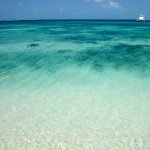
Cheguei em Puno cedo, umas 12 horas de ônibus de Arequipa, e fui procurar por transporte para as ilhas do lago Titicaca. Almocei e voltei para o hotel para esperar por alguns amigos brasileiros. Era a primeira vez que alguém “de casa” vinha me encontrar. Eles, Jeferson e Carol, chegaram no meio da tarde. Estavam atrasados no seu cronograma de viagem devido às greves dos campesinos na Bolívia. Decidiram não conhecer as ilhas e ir direto para Cusco. Jantamos e eles pegaram mais um ônibus
No dia seguinte, parti em um tour de dois dias pelas ilhas. Primeiro conhecemos a ilha Uro, por coincidência chamada Santa Maria, mesmo nome de minha cidade natal. A ilha é bem pequena, toda feita de palha. Primeiro eles colocam as raízes de junco e por cima a palha seca. Com o tempo as raízes vão crescendo e dão resistência ao “chão”. Há umas estacas de madeira que “trancam” a ilha na terra, são como ancoras para que ela não fique se movendo pelo lago. A primeira pisada na ilha é estranha, pois o chão é fofo. Tudo me pareceu bem turístico. As pessoas estavam todas do lado de fora de suas casas com souvenir para vender, parecia que passavam toda a manhã esperando os turistas.
Mais umas 3 horas de viagem de barco até a ilha Amantani. Chegando lá, fomos recebidos pela autoridade local (prefeito talvez), que distribuiu os turistas nas casas das pessoas. Fiquei na casa de Rebeca, com mais duas americanas. Ela nos acompanhou até sua casa onde cozinhou nosso almoço (sopa, arroz, batata com ovo e chá). Depois nos acompanhou até o lugar de encontro marcado pelo guia. Como a ilha não tem estrutura de cidade (é quase tudo população rural), fica difícil se localizar, pois os caminhos são pequenos e por entre os terraços. De lá, caminhamos até a parte mais alta da ilha, o templo Pacha Tata. Já era tarde, estava frio e começando a escurecer. Na volta para casa, o filho de Rebeca (de 9 anos) nos esperava para nos acompanhar. Sendo noite, acho que, se ele não estivesse ali, nunca acharia o caminho de volta. A janta nos esperava, comida simples e muito boa.
No outro dia, depois do café da manhã, fomos para Taquille, uma hora de barco de Amantani. Desembarcamos na parte mais alta da ilha e fomos caminhando até a Plaza de Armas da pequena cidade. Esta ilha também tem população essencialmente rural. São dois mil habitantes, mas parece bem menos. Caminhamos pelos caminhos entre os terraços e fomos almoçar. Desta vez a famosa truta, trazida dos Estados Unidos e introduzida no lago nos anos 50. Durante o almoço, o guia explicou a vestimenta da ilha, como o gorro usado para diferenciar os solteiros dos casados e também a gente mais importante da comunidade. Depois do almoço, o grupo voltou para Puno e eu fiquei para dormir na ilha. Consegui um quarto com a família da dona do restaurante onde comemos. A tarde estava muito fria até que começou a chover e, logo em seguida, nevar. Fiquei no quarto vendo a neve cair. No final da tarde, quando parou de chover, saí para caminhar e parei na Plaza de Armas para tomar um mate de coca. Estava tudo vazio, os turistas tinham ido embora e as tendas estavam fechadas. Foi ótima a sensação de estar sozinha, longe de grupos de turistas.
A manhã seguinte estava ensolarada. Acordei cedo para caminhar e fotografar um pouco da paisagem local. À tarde, voltei para Puno.






Social Profiles